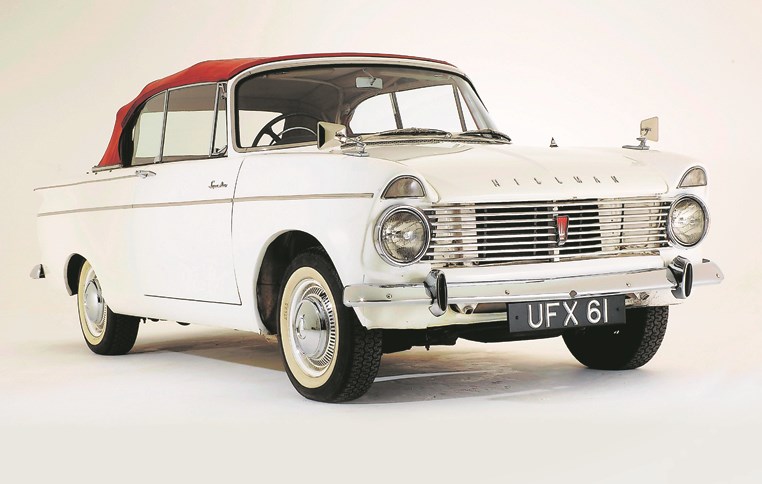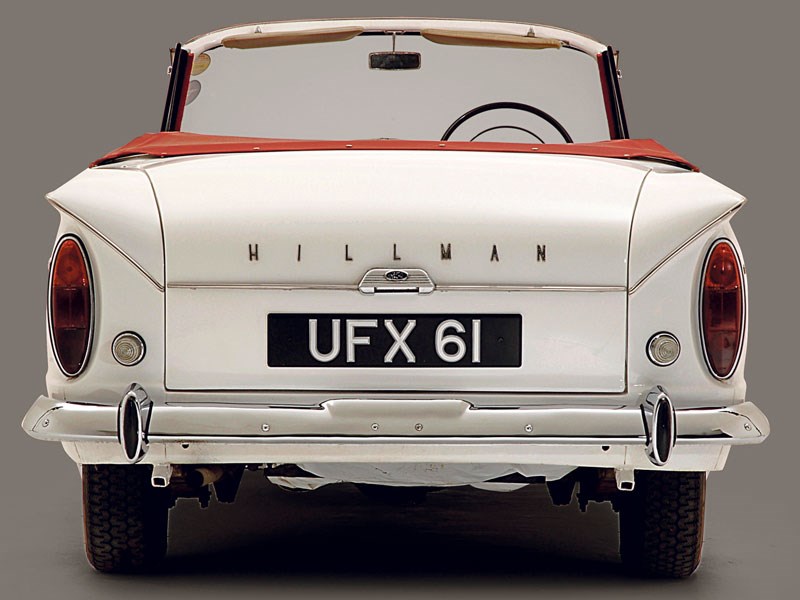Often overlooked, the Super Minx range offers up something for everyone.
The driving position is surprisingly good, with a decent range of seat adjustment. The steering wheel is offset a little from the big pedal pads, but you soon became accustomed to this. The car is free from serious wind noise at high speed, and the ride on all but rough surfaces is good, with the high spring rates limiting bounce and pitch and a stiff front anti-roll bar limiting roll movement.
Handling is almost identical to the rest of the Hillman and small Humber group, and errs on the side of final understeer. While the effect of this is to make the car a little heavy to haul around short, tight corners, it makes it very safe and stable at sensible speeds. The steering is quite light and accurate, but does get a little spongy towards each extremity of lock. Despite the use of a live rear axle and conventional springing, it is difficult to induce axle tramp. The Mark II has slightly improved disc brakes, and stops well for a family car, with average pedal pressures and no sign of fade under normal use.
VITAL STATISTICS
1961 Hillman Super Minx
Engine 1592cc/4-cyl/OHV
Power (bhp@rpm) 62bhp@4800rpm
Torque (lb ft@rpm) 84lb ft@2800rpm
Top speed 80mph
0-60mph 20sec
Consumption 25mpg
WHAT TO LOOK FOR
BODYWORK & CHASSIS
Super Minxes were poorly rustproofed when new, so most have required major repairs by now. Wheelarches often rot out, so check them carefully for filler. Wings themselves last well, but corrosion can often occur where the inner and outer panels meet. Front valances and the leading edge of the bonnet are other common rot spots.
Also examine each sill along its length, especially on convertibles – the structural strengthening that runs along the underside can rust badly, with uneven door gaps being a tell-tale sign that this has occurred. Spring hangers corrode along with the rear footwells, while you also need to examine the fuel tank. Chances are that the underside of the tank itself will have rusted, along with the panelling surrounding it – repair in this area is tricky, so be on your guard. Finally, always check the drainage holes aren’t blocked.
Check the underside of each door, as rust there is difficult to spot from the outside. Door skins can also rot badly, but the door frames themselves tend to be resilient. You also need to lift up the carpets and have a good look at the metal beneath, particularly in the front footwells – leaking windscreens mean water is often trapped there, with obvious and troublesome consequences.
ENGINE
Super Minxes used a 1592cc engine until 1965, when it was replaced with a 1725cc version of the same unit. The former is capable of over 100,000 miles between rebuilds, while the beefier latter can manage around double that figure. Whatever unit is under the bonnet, dip the clutch to see if the revs drop, betraying worn main bearings and tired rear crankshaft thrust washer. The only fix is a bottom end rebuild. Rattling from the front of the engine suggests a worn timing chain, while excessive tappet noise could be due to poor adjustment, though worn tappets and followers are more likely. The 1725cc unit has a cast-iron block and a head of either cast iron or alloy. It’s crucial that anti-freeze has been maintained at a ratio of 50:50 in order to prevent internal corrosion
RUNNING GEAR
Gearboxes offered for Super Minxes included a conventional manual or less common automatic. The former didn’t receive synchromesh on first gear until 1964. Overdrive was available as an option from the beginning of production, but few buyers specified it, and consequently it’s very desirable today. If overdrive is present, then make sure it functions smoothly – any problems are likely to be electrics-related, so check for a duff relay, solenoid or dodgy wiring connections. A Smiths Easidrive automatic gearbox was available until 1962, before being replaced by a Borg-Warner 35 unit, but you’re unlikely to find a car with the former today.
BRAKES
Steering is via a recirculating ball steering box, that needs to be examined for leaks and overtightening. Any tight spots as you turn the wheel are indicative of the latter. Unless they have been horrendously neglected however, the ‘boxes will rack up extensive mileages. All Super Minxes have front disc brakes, apart from very early cars up to October ’62.
INTERIOR
Damaged seats are a particular problem, usually only fixed by investing in a retrim. Look out for splits and tears, as well as stitching coming undone. Driver’s seat diaphragms suffer through years of use, as the rubber membrane sags and breaks. Repairs need to be effected with webbing, as originals are no longer available. when examining a prospective purchase. A large number of detail changes over the years make tracking down exterior trim difficult.
OUR VERDICT
Announced in October 1961, the Super Minx gave Rootes an expanded presence in the upper echelons of the family car market. It was bigger, heavier and accordingly more expensive than the mere Minx, so Rootes management decided to release it as a separate model, with ‘Super’ added to highlight its improvements. The body retained the family resemblance, but underneath the mechanicals were broadly the same. Alongside saloon and estate models, a fetching four-seater convertible was introduced in 1962.
The Super Minx engine originally had a cast-iron cylinder head, though on later cars this was replaced with an aluminium version. Suspension was independent at the front using coil springs with anti-roll bar and at the rear had leaf springs and a live axle. The Super Minx saloon and its Singer relatives were replaced by the Rootes ‘Arrow’ range when the Hillman Hunter and Singer Vogue were launched at the London Motor Show in October 1966.
It’s hard to see why Super Minxes still seem so underrated – they are eminently usable, practical and are more than capable of keeping up with modern traffic. Specialists are few and far between, but great club support should help point you in the right direction, so find a good one and you won’t regret it.

